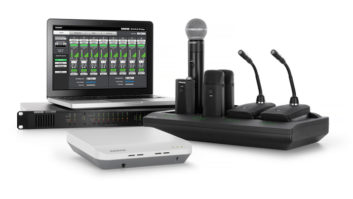There has been much talk about the sky falling down on wireless microphones. So far the RF environment, like the air quality in major metropolitan environments, has been slowly deteriorating with increasing traffic. This year users of wireless mics in America’s largest cities are likely to encounter interference on many frequencies that were previously trouble-free because there will be twice as many vehicles clogging the airwaves.
The FCC has set an aggressive seven-year schedule for the transition to digital television (DTV). While continuing to broadcast analog (NTSC) signals on current frequencies, each of the nearly 1,600 U.S. television stations has been assigned a second broadcast frequency for DTV.
Wireless users in several cities have already been affected by the two dozen stations that volunteered to complete their transitions early. Affiliates of the four leading networks in the top ten markets will broadcast DTV by May, with the next 20 markets due by November. Other commercial TV stations have three years to get started, and public stations have four, but stations may move even more quickly than the schedule indicates because there are financial advantages to encourage broadcasters to get DTV on the air quickly.
In addition, because other data can be broadcast simultaneously, stations can add revenue by also transmitting a variety of ancillary and supplemental subscription, data or Internet-based services, or even a second broadcast signal. Examples might include paging services, programming schedules, computer software, electronic newspapers and pay-per-view programming.
Transmitting a Standard Digital TV signal (SDTV) instead of HDTV leaves even more broadcast bandwidth for other uses. PBS stations already need fund-raising telethons and are hoping that the supplemental services broadcast along with DTV will give them an additional revenue stream. All of these factors will further clog the airwaves available to wireless users.
SPECTRUM COMPLICATIONSTelevision channels are spaced out on frequencies that are 6 MHz apart. VHF channels 2 to 6 operate from 54 to 88 MHz, and channels 7 to 13 are from 174 to 216 MHz, with FM radio in between. UHF channels 14 to 69 operate from 470 to 806 MHz.
The FCC has designated channels 2 though 51 as “core” channels, planning to eventually end up with all DTV broadcasts below 700 MHz after the transition is complete. As analog transmissions end and those frequencies are once again available, stations with DTV assignments above channel 51 will move a second time, back into the core spectrum.
The FCC has also reallocated TV channels 63 to 64 and 68 to 69 for public safety transmissions, including both mobile units and more powerful base stations. As the transition ends, the remaining “Sixties” channels will be auctioned off for new wireless services. The U.S. government has been auctioning off the airwaves to help balance the budget, reaping billions of dollars from the sale of spectrum first to cell phones and now to broadcasters. These windfalls are likely to whet politicians’ appetites for more, and it’s only a matter of time before they auction off more spectrum.
Although all these frequencies may be clear for a long time in rural areas, in the major markets that see the preponderance of entertainment wireless use, interference should not come as a surprise. In several U.S. cities, one or two unoccupied UHF channels of the first seven are already used by land mobile radios, which is one reason why few manufacturers make UHF systems below 512 MHz.
TV channels 52 to 59 (698 to 746 MHz) are above the core TV allotment and below the new public safety spectrum. It would seem a good bandwidth for short-term strategies in the transition period, but there are exceptions. For example, in Alabama there are ten DTV allotments in the Fifties channels, and current analog broadcasts, though there are fewer, will continue for at least the next half-dozen years.
Analog TV signals have separate picture and audio components that don’t take up the entire band, with the sound offset from the picture by 4.5 MHz, allowing transmission in the “slot” frequency between the picture and sound in some cases. In the new DTV format, much of the 6MHz band is full of digital transmission.
Wireless microphones operate over the airwaves as secondary users, and they must accept interference from TV stations. Interference symptoms range from mild to extreme noise and complete failure, depending on the relative signal strengths and type of wireless. When you see a DTV signal on an RF spectrum analyzer, it looks like background noise that has been raised in level over most of the 6MHz bandwidth, with a higher peak in the side-band carrier in the lower portion.
In the early stages, many stations may not broadcast a DTV signal all the time. After intermittent testing at various power levels, some may initially only broadcast prime-time or special events. For sound reinforcement professionals, this means the spectrum could be clear at soundcheck, and then broadcasting might start during your show.
SOLUTIONS AND STRATEGIESWireless users need to plan for all interference possibilities so that they won’t be affected when DTV broadcasts suddenly start. The new DTV frequencies are well-known to wireless manufacturers and can be found on the FCC’s Web site. A list of the latest DTV allotments is available on the Net at www.fcc.gov/oet/dtv/.
Up till now, casual users simply turned on the wireless needed for their show and hoped for the best. Frequency-agile equipment that can be tuned across the span of several UHF TV stations to shop for clean channels provides a sense of security. With the coming decrease in the number of clear channels, careful planning becomes the best protection for shows that rely on wireless equipment. The problem of finding enough clear frequencies is already being faced in places like Orlando and on Broadway by heavy users of wireless who are only able to get enough channels to work after intense frequency coordination.
With frequency-agile wireless, the ability to move to a new spot on the dial is limited to the range that the user is able to tune. And with crystal-based fixed-frequency systems, if it doesn’t work, you need to go to another unit. Re-crystaling fixed systems and moving the splits on synthesized systems is becoming a major activity at manufacturer and third-party service centers.
Even if your production is only using a few channels of wireless, you’ll want to start by preparing a three-part frequency list. First, list the frequencies that your current inventory runs on. Then list the known conflicts with current TV and other radio services. Add to this the proposed future conflicts with local DTV stations and other radio services. These frequencies can all be compiled in a single spreadsheet with columns for current conflicts, future conflicts and your inventory. This is only the beginning, though. Full frequency coordination includes calculation of the intermodulation of all signals, which is beyond the scope of most wireless users but can be done with special software by some wireless vendors and manufacturers.
This information can be printed out and included each time wireless is used on a show. Even if you’re not sending out your wireless equipment, it can be helpful at one-offs and festivals so that visiting acts can be warned about conflicts. Those using local production will appreciate a heads-up about the local RF environment if they haven’t already taken the trouble to coordinate the frequencies they’re carrying.
ROAD WARRIORS RUN THE RF GAUNTLETIn touring applications, shows with multiple wireless products face another problem; they must carry inventory that will provide enough channels to fulfill the show’s requirements in each new location. Even with frequency-agile equipment, certain combinations of major-market itinerary and wireless requirements could make it cost-effective to subcontract equipment from a vendor that can also offer frequency coordination, technical training and the ability to drop-ship equipment into known trouble-spots.
In many large cities, when you add the new DTV channel allotments to existing assignments, there are not a lot of open airwaves left for the use of entertainment wireless systems. Depending on where you are in Los Angeles, for example, there will be as few as a dozen unassigned TV channels. After you take away the highest ten channels, only about eight are open. Frequency-agile systems allow dozens of wireless channels to operate simultaneously but can only be tuned by the user over a bandwidth that spans a half-dozen TV channels. One perception is that fixed-frequency systems are inferior and old-fashioned, but remember that the advantage of an agile system is wasted if most of its frequencies are being stepped on by DTV. There is a limited range of solutions to problems that crop up during soundcheck.
Although inexpensive handheld scanners can help identify analog broadcasts, spectrum analyzers are needed to monitor DTV and other digital transmissions accurately. Manufacturers have begun including spectrum scanning in their systems, but they can only tell you what is happening at the moment. A 24-hour scan offers information that can better predict what may happen over time. Some types of interference are intermittent or occasional. I won’t bother to tell the whole story of the church next to the National Guard Armory, which never had problems on weekdays when their vendor came to check the wireless that had been acting up over the weekend.
So you can see that, because touring acts will find themselves in a wildly dynamic RF environment in the next few years, more advance planning and frequency coordination will be required than ever before. It may make more sense to rent wireless equipment from a vendor with deep technical resources and heavy inventory that can cover every eventuality and offer solutions that begin with pre-tour coordination for a proposed itinerary. It may also make more sense to manage inventory that is being carried than to have a package that tries to cover all the bases. There might be special packages for places like Radio City and Shaky Town that could be drop-shipped or obtained locally instead of carrying them for the entire tour.
Familiarity with RF technology is becoming a requirement for at least one member of any audio crew whose show relies on wireless. Instead of providing technicians along with sub-hired wireless packages, many vendors spend time training one of the show’s audio techs. A large enough rental might also include a portable spectrum analyzer.
Since we’re in the early part of the transition phase, we’ve only seen the tip of the iceberg. If you’re using wireless microphones in the 30 largest American cities, it is likely that one day this year you will suddenly find interference that wasn’t there before. Planning for that day will allow you to avoid RF conflicts and focus on more important audio issues. And having good alliances with specialists, whether they’re manufacturers or vendors that sell and rent systems, will help you prepare. For occasional use or special projects, try renting from vendors that specialize in wireless equipment. Everyone purchasing wireless this year should consider their choices carefully.
BREAD PANS REDUCE WIRELESS INTERMOD NOISEWhat happens when two or more wireless mics are separated by a few inches, like when they’re sitting in a row on the monitor console just before they get handed out? Because of the inverse square law, the intermodulation product of spurious emissions increases at twice the rate of the signal strength. Transmitters that behave perfectly fine by themselves, and even several turned on at once when they’re placed across the stage on mic stands, will cause each other to act up and get noisy when right next to each other, especially near the receiver. This does not reflect how they sound once they’re in the performers’ hands, but it can drive engineers crazy who are trying to check them right before they’re being used for a big show. One solution we’ve heard of is to get several $2 metal bread loaf pans. Putting each mic in a metal pan isolates it from the others enough to cut down the spurs when they’re in close proximity.



